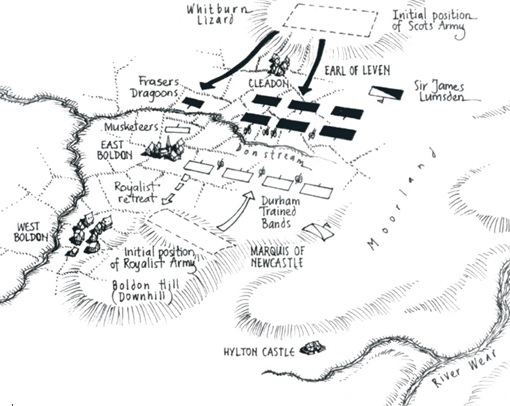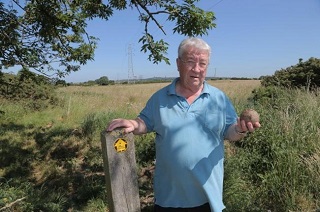

The Battle of Boldon Hill 1644 was a brief engagement between the Royalist Forces under the command of the Marquis of Newcastle and the Parlimentary Forces (Scottish Covenanters) commanded by the Earl of Leven. Why it was called the Battle of Boldon Hill is a mystery as all the reports from various sources describe the battle as taking place on the relative flatlands around the villages of East and West Boldon. Boldon Hill Was merely where the Royalist encampment was located and the Parlimentary encampment was on equally high ground at Cleadon Hills opposite.
Further discussion on the Battle location can be found on this link
On the 23rd of March the Marquis of Newcastle marched the army towards Sunderland along the north bank of the Wear in the hope this would persuade Leven to abandon South Shields. Leven moved to meet him and both armies drew up in order of battle once again. Newcastle formed up on Boldon Hill (now known as Down Hill), Leven on Whitburn Lizard three miles away. The Scots managed to get some heavy guns across the river, although two were lost when their boat sank - one was dredged up in the 19th century and now stands in one of Sunderland's parks. For the rest of the day both sides engaged in a rather ineffectual cannon dual. Late in the afternoon, Fraser's Dragoons opened the battle with an attack on some Royalist musketeers who were lining the hedges around the village of East Boldon. The fighting became fierce, according to a Royalist newspaper four Royalist regiments faced six Scots ones. The fighting went on throughout the night.Eventually, Marquis of Newcastle's men were driven out of East Boldon and retreated up Boldon Hill, the Scots retired back to their main position on Whitburn Lizard. The Royalists later admitted to losing 240 men in this encounter.
Source: http://1644-siegeofnewcastle.8k.com/campaign.htm

A Scottish Soldier Writes:
“On Sunday, March the 24th the enemy marched towards our quarters intending to have set upon us in Sermon time, and being a foggy day to have surprised us; their approach being discovered, a great port of the army was presently drawn together.
The enemy sent down from Boldon Hill Where they were drawn up, some commanded musquetiers to line the hedges betwixt them and us, and we did the like, for the armies could not join, the field between us being so full of hedges and ditches; our dragoons began the play, and then the musquetiers in the hedges upon both sides, our bodies of foot advancing at all quarters to the hedges, the enemies cannon discharging upon them an hour and a half with very small hurt. This service continued very hot, till after twelve of the clock at night. Many officers, who have been old soldiers, did affirm they had never seen so long and hot a service in the night time; there were divers killed on both sides, but the number of their slain did very far exceed ours as we understood by the dead bodies we found the next day upon their ground, beside the seven wagons draught of dead and hurt men not able to walk, that the Constable of Boldon affirmed he saw carried away. The enemy quit their ground where they left much of their powder, match and arms behind them; and retired to the hill where the body of the Army lay.”
On Tuesday the 26th Newcastle withdrew to Durham en route to York.
Source: How the Scots Won the English Civil War: The Triumph of Fraser's Dragoons
By Alisdair McRae, Chapter 2 Battle of Boldon Hill
Approximate strength of the Opposing forces
| Royalist | Parlimentary |
|---|---|
| Army of King Charles (Wm Cavendish, Marquis of Newcastle)
Horse (Sir Chas Lucas) – approx 2000 Lord Mansfield’s RoH (Lt.Col Sir Francis Wortley) Sir Richard Tempest’s RoH [Durham] (Lt.Col Sir Francis Liddell) Sir Edward Widdrington’s RoH [Northumberland] (Lt.Col Henry Constable) Sir William Widdrington’s RoH [Northumberland] (Lt.Col John Thornton) Col. Francis Stuart’s RoH [Northumberland] (Maj. Nicolas Burnet) Foot (Lord Eythin) – approx 4300 Marquis of Newcastle’s RoF (Lt.Col Sir Arthur Basset) Col. Charles Brandling’s RoF [Northumberland] (Lt.Col Robt Brandling) Sir Wm Lambton’s RoF [Durham] (Lt.Col Henry Lambton) Col. John Hylton’s RoF [Durham] (Lt.Col Lynsley Wren) Col. John Lamplugh’s RoF [Cumberland] (Maj. Christopher Dudley) Durham Trained Band (Maj. Arthur Swindells) | Army of the Solemn League & Covenant (Lord General Alexander Leslie, Lord Leven) Horse (Maj.Gen David Leslie) – approx 1600 Lord Kirkcubright’s RoH (Lt.Col James Mercer of Aldie) Earl of Leven’s RoH (Lt.Col James Ballantyne) Maj-Gen David Leslie’s RoH (Lt.Col Sir John Brown) Col. Hew Fraser’s Dragoons (Maj. John Munro) Foot (Maj.Gen Sir James Lumsden) – approx 5200 Sir Alexander Hamilton’s RoF [Clydesdale] (Lt.Col Wm Carmichael) Earl of Loudoun’s RoF [Glasgow] (Lt.Col Robt Home) Earl of Lindsay’s RoF [Fife] (Lt.Col Thos Moffat) Lord Livingston’s RoF [Stirlingshire] (Lt.Col Andrew Bruce) Earl of Lothian’s RoF [Teviotdale] (Lt.Col Patrick Leslie) Master of Yester’s RoF [Linlithgow & Tweeddale] (Lt.Col Wm Johnston) Earl of Buccleuch’s RoF [Tweeddale] (Lt.Col Walter Scott) Earl of Cassillis’ RoF [Kyle & Carrick] (Lt.Col John Kennedy) 1 heavy gun, 2 light, 1 frame |
| Note in Bold Col. John Hylton, He was the future owner of Hylton castle located next to the Royalist Encampment. The Castle had been given away to Charity by one of his ancesters Henry Hylton, de jure 12th Baron Hylton in 1641 for a period of 90 years just 3 years before the battle. During the restoration the castle was passed back to him by the crown (presumably in payment for his services to the Royalist cause). |
 |

|
Here we have an English Civil War cannon ball found on the battle site near Occcupation Road in the cleadon hills area which were Occupied by the Parlimentary Forces during the battle.
TERRY Miller 73, lives in East Boldon, found the cannon ball while out walking. “I wasn’t really looking for it but it’s amazing what you see when the farmers are ploughing up the winter crop. It’s the first time I’ve ever heard of one being found.” Though unable, reasonably enough, to confirm that it was a 1664 missile, the cannon ball has since been weighed and measured by the Great North Museum, on the site. Whilst doing so they noticed flash marks and confirmed that it had been fired. It weighed 5lbs. Possibly fired by a Saker due to the weight of the shot. The saker had a calibre of approx 3.5" whilst the Cannon in Barnes Park has a calibre of approx 5.25" so that is more likely to be a Culverin. It was not uncommon for the armies to have different calibre guns during a battle, some for long potshots others for more closeup work. “That’s the first thing everyone asks,” says Terry. “I know that the battle’s history is a bit sketchy, but if people died, you can see why. You wouldn’t want to be hit by that thing, would you?” The Cannon ball found by Terry Miller source : Northern Echo |